The German "Panther" and "Tiger" tanks were considered so powerful that they were almost indestructible. American soldiers panicked at the mere news that they were operating in the area. US Army tankers, fighting on not very successful Shermans, begged their commanders for better equipment that would allow them to fight the German monsters on a balanced basis. They finally got such a machine, although it was definitely too late. The great tank - the M26 "General Pershing" - reached the front only in the last weeks of the war.
The US Army was not prepared to participate in World War II. The armaments and equipment were outdated and not suited to the conditions of a modern battlefield. But what is the industry for? After the Japanese attack on Pearl Harbor and the US entered the war, the country's powerful production machine was quickly converted to military production.
Every few seconds, guns and mortars, jeeps and trucks, rifles, ammunition, helmets, shovels and bayonets came off the production lines. Ships and ships were mass-produced (stream method) in shipyards, and thousands of fighters and bombers were built in aviation factories. It was also necessary to catch up with the "rear" in armored weapons, which were particularly backward.
Sherman enters the game
To begin with, the project was quickly developed and the production of the "General Sherman" tank, structurally based on the older M3 "Lee" tank, started. In February 1942, Shermans began to roll off the line, and in July they made their debut at the Battle of El Alamein in North Africa. Since then, they fought, among others in West Africa, Sicily, Italy, and from June 6, 1944 also in Normandy.
The enemy at that time was also awake. German engineers and armament factories were at full blast and the Panzerwaffe gradually replaced the old PzKpfw IV tanks with perfect panthers and mighty tigers. Meeting them on the battlefield was a painful experience for Americans. The gloomy fame of the panthers in the US Army was so great that the replenishment soldiers panicked at the mere news of their appearance in the area.
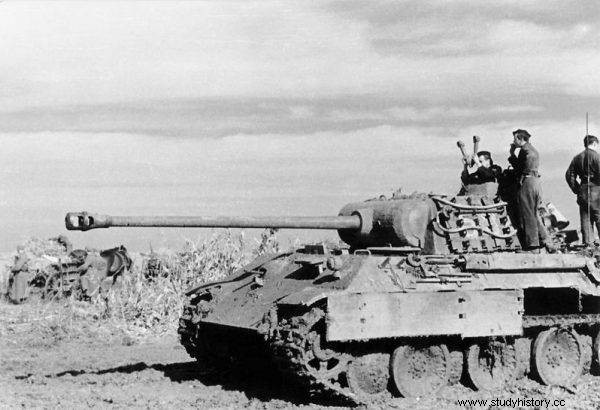
Panther on the Eastern Front
Fortunately, the Allied air force ruled the air, so the formidable "panzers" could be destroyed or stopped by air bombardment or rocket shelling. But when the weather did not allow the Thunderbolts to fly, it got a bit bleak. The Panthers were technically superior to the Shermans and their counterattacks were extremely effective.
Five against one
American tankers realized the weakness of their machines. They did not take part in duels, attacked in large groups, with an advantage of at least 5:1, they tried to surround enemy armored vehicles and attack them from the rear and from the sides. After spotting the German tanks, they immediately called for help from the air force.
While the fighting was still taking place near the coast, they received fire support from the sea. The large ships fired 40 kilometers inland, and even if they failed to hit the target directly, the blast of the blast alone was enough to kill the crew and knock over a Panther or a Tiger.
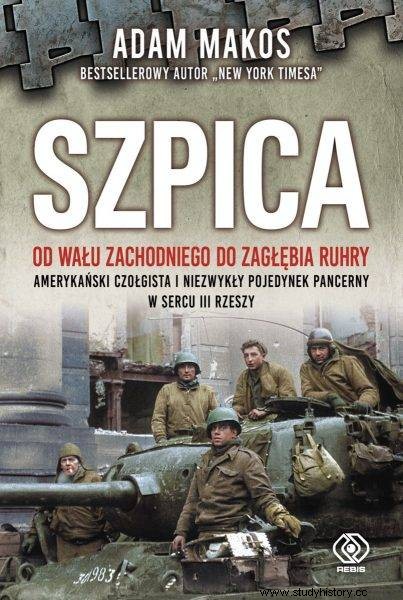
The text was created, among others based on the book by Adam Makos' Szpica. From the West Bank to the Ruhr Area ”, which has just been released by the Rebis publishing house. Buy now
Although the Germans defended themselves hard and the fighting for cities (e.g. for Caen) lasted for many weeks, ultimately the Allied success was determined by numerical superiority and logistical support. Suffice it to say that there were times when the Germans had 500 tanks on the Western Front, while the English and Americans had 20,000. . Even the perfect guns and armor of panthers and tigers couldn't help it.
Sherman is angry
From the time of the Normandy landings, American armored personnel reported on the shortcomings of the M4 Sherman. They reported that the shells of the 76 mm cannon did not penetrate the frontal armor of German tanks. Gasoline-powered Shermans caught fire easily, and the crews named them "Ronson" (for a brand of lighters). The gun's accuracy was poor because the muzzle velocity was low, the tracks were too fragile and they broke off easily, and "the chassis was bad too."
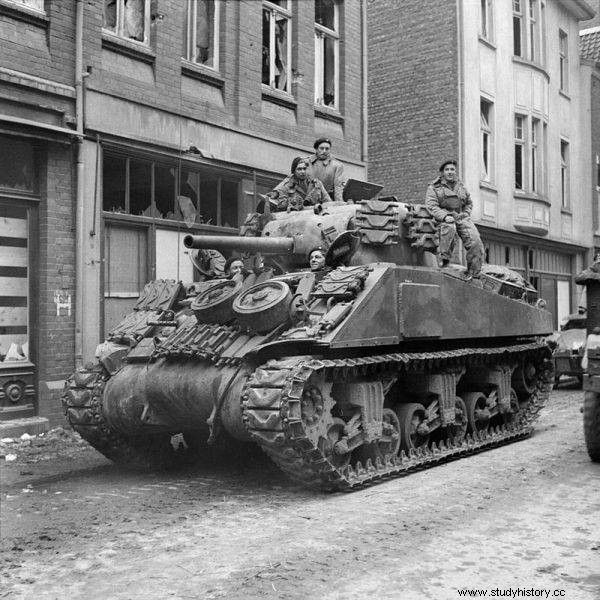
photo:Hutchinson (Sgt), No 5 Army Film &Photographic Unit / public domain Shermans equipped with gasoline engines ignited easily, so the crews named them "Ronson" (from the brand of lighters)
Some of these problems were eliminated in factories - the engine was changed, barrels of larger caliber were inserted, and the armor was strengthened. However, it was still not enough. The Americans were about to enter Germany, and there not only panthers and tigers, but also dangerous 88 mm guns and new PzKpfw VI Ausf tanks were waiting. B Tiger II, known as the "King Tiger" . So, provisional solutions were used. Adam Makos describes them in a book full of various details and flavors, "Szpica. From the West Wall of the Ruhr. An American tanker and an extraordinary armored duel in the heart of the Third Reich ":
In the 7th US Army, steel baskets were mounted on the Shermans and then filled with sandbags. Another popular DIY solution was pouring concrete over the frontal armor of the tank to strengthen it . In the 9th Army, steel track links were used, welded to the front armor, and additionally covered with sandbags secured with mesh.
Patton ordered his 3rd Army to double the thickness of the front armor of the Shermans using steel plates obtained from the wreckage of American and German vehicles. In turn, in the 1st Army, the "Spearhead" Division experimented with additional steel plates and concrete armor on selected vehicles.
Pershing arrives at the front
In addition to sandbags and track links, the Americans were finally getting something more tangible. Finally, a new tank arrived at the front to face panthers and tigers. Its transport to Europe and its introduction to combat was "piloted" by Dwight Eisenhower himself, the Commander-in-Chief of the Allied Forces in Europe.
It was a T26E3 Pershing machine weighing 46 tons, with a crew of five and a 90 mm gun. Mass production began in November 1944 and was carried out at a frantic pace so that the tanks could still fight in Europe.
In the first batch, only 40 were produced, 20 of which were sent for testing at Fort Knox, and the rest were immediately shipped to Europe . On February 17, 1945, the tanks reached Aachen (i.e. Aachen), where the technical services prepared them for taking over by the crews. Selected, the best sherman crews switched to pershing with undisguised joy. 10 new tanks went to the 3rd Panzer Division called "Spearhead", the rest to the 9th Panzer Division.
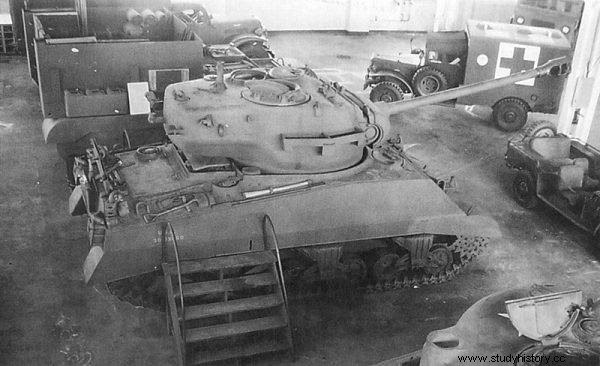
Mass production began in November 1944 and was carried out at a frantic pace so that the tanks could still fight in Europe.
One of the first pershing (serial number 26) was received by a very experienced crew, commanded by Sergeant Robert Early. His gunner was Clarence Smoyer, a true "tank sniper." This is how he recalled the first moments in the new tank:
Inside, Pershing was freshly painted white. Clarence took his seat next to the 90mm gun that the US Army touted as "the most powerful weapon we have ever fitted into a tank" . Its periscope was fitted with a powerful telescopic sight with 6x zoom, which was a great advance that almost ruled out the necessity of constantly jumping from one to the other.
This solution allowed American tankers to aim at a specific point on the armor of a German tank, which they could not do until now due to poor optical instruments. The training of the pershing crews was kept to a minimum and on February 23 they were battle-ready.
Direction:Cologne
General Maurice Rose, in command of the 3rd Panzer Division, had specific plans for pershing. Soon his troops would attack Cologne, "the queen of German cities." The Americans expected that the capture of this city and the crossing of the Rhine would allow them to penetrate deep into Germany and lead to a quick end of the war.
It turned out, however, that were still awaiting difficult battles, bloody counterattacks by the Germans (in one of them, General Rose was killed), as well as real tank battles incl. about the city and the Paderborn training ground, where most of the German tankers were trained. But first there was Cologne and the famous Pershing vs. Panther duel on March 6, 1945.
The Germans transferred the remnants of the 9th Panzer Division and the 363rd People's Grenadier Division to the city. The center was defended by two panthers and one PzKpfw IV. The brand-new Pershing of the 3rd DP "Spearhead", sheltered by Shermans, slowly made its way towards the cathedral in the center, while foot soldiers searched the buildings on either side of the street and escorted single prisoners to the rear.
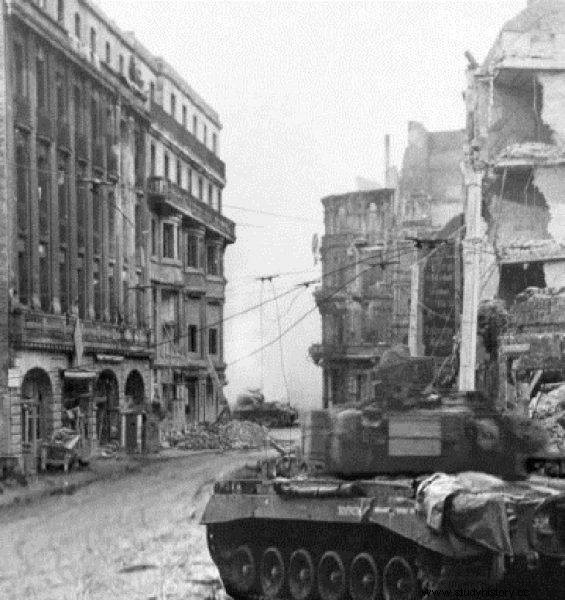
General Maurice Rose, in command of the 3rd Panzer Division, had specific plans for pershing. Soon his troops were about to attack Cologne, "the queen of German cities."
The Germans willingly surrendered, but there were exceptions, incl. "Tank hunters" armed with panzerfausts. One of them, who was lurking in the gate, managed to "take off" the Pershing crew, although the tank gunner pressed the gun trigger instead of the machine gun trigger pedal . A cannon shell ruined the tenement house, and the German was covered with rubble. At the next intersection, a more dangerous enemy waited - the Panther, who had already destroyed one Sherman and damaged the other. Adam Makos in Szpica writes:
The panther rolled past the cathedral and stopped in the corner of the square, facing the abandoned Sherman wreckage. The German tank had fired from the tunnel under the railway embankment before, and now it came out of the shadows to confirm its control of the battlefield. His commander also appeared in the light of day. Bartelborth stood erect in the tower.
With no bridge behind them to defend themselves, German soldiers were desperately trying to get to the other side of the Rhine, using torn doors or planks as makeshift rafts. Bartelborth and his crew, however, decided to do otherwise. Bartelborth never made his men fight to the last bullet. There was no such need. They stayed there to fight until their deaths. Pershing stood less than three hundred yards away on the parallel wall of Cologne's Wall Street. His engine was idling.
It was the moment when it turned out which tank would be better in a real duel, fought in the style of Wild West gunslingers. The "nine-month-long dispute" that had been growing since the Normandy landings was also about to be resolved - can any American tank fight the Panther on an equal footing?
The incredible fact is that the course of this clash was recorded on film frames. It was done by Jim Bates, the front operator of the 165th photo and communication company, who located himself with the camera in a place from which he had a view of the German tank. He managed to record a 45-second duel.
Pershing and Nashorn
The only Pershing lost in combat during the war of the year was hit at a short distance (250 meters) by a shell fired from the Nashorn tank destroyer gun of the 2nd company, 93.sPzJägAbt. This happened in Niehl near Cologne.
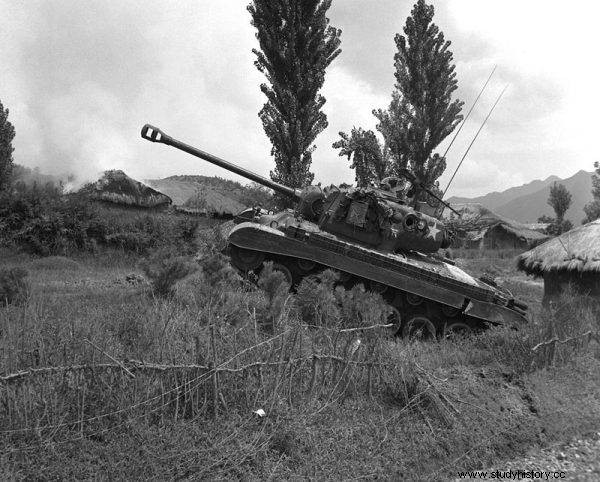
Pershing during the 1950 Korean War
The crew of the American tank survived, but the burned-out machine was no longer fit for repair and it was taken from the records. Pershing could indeed take an equal fight with panthers, and they definitely dominated the PzKpfw IV . They also destroyed some tigers.
After the end of the war in Europe, they were sent to the Far East, where it was planned to use them in battles with the Japanese. However, due to delays in shipping, they reached Okinawa after operations were completed. Pershingas served for many more years. in the Korean War, where they fought very well against North Korean T-34/85.
